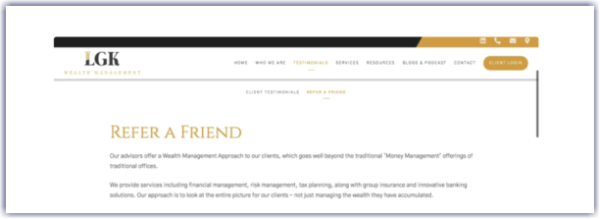
Referral programs help generate qualified leads, bring in more clients, and increase your revenue. That’s why a financial advisor who is asking for referrals likely makes more money than one who isn’t.
A referral marketing program is easy to run and will work for your financial services business. Interested in knowing how it all works? This referral marketing guide introduces you to the ins and outs of a referral program and explains how you can use a referral program to help your business grow.
Get the expert marketing advice and tools you need to find new financial clients and increase investment from existing ones.
What is a referral marketing program when it comes to financial advisors?
As you know, a referral is when one of your current clients recommends your services to a friend or family member. A referral program is when you actively ask for, and track, these recommendations, whether you provide something in exchange or not.
And while a referral program helps to bring in leads, it’s important to remember that the referral isn’t a success until the lead completes a deal with you — namely, pays you for your financial services.
The benefits of asking for referrals
Asking for referrals can sometimes make people feel embarrassed, so is it worth it? It absolutely is — and it’s nothing to be embarrassed about. There are two big benefits of asking for referrals.
First, it makes your current customers feel a lot closer to you as a business. After using your financial services, a customer might feel indifferent about your company. After they refer someone to your business, however, they might feel more connected because they’re playing an active role in helping your business succeed. This closeness results in a more loyal customer base so you can expect to see more return business.
Secondly, these referrals don’t cost you anything. This is really good news for your company. You don’t have to spend money on ads or workshop an idea to get new customers. More importantly, you don’t have to nurture a lead through the sales funnel until they’re at the “ready to buy” stage. It’s almost like having someone show up on your doorstep ready to give you money.
Where to ask for referrals
One of the best referral sources for financial advisors is your current network of customers. It might seem obvious, but you need to talk to your current customer base in order for a referral to happen. Where should you go to find referrals? You have a lot of options.
In-person
After wrapping up an in-person meeting or closing a deal with a client, you can ask them face-to-face if they can refer anyone.
There’s a lot of power in asking for referrals face to face. It shows that you’re genuine and you care about your company. It’s also harder for the client to ignore your request when spoken to directly.
Many financial advisors have a pretty comprehensive mailing list. As you probably know, email marketing for accountants and financial services is important.
Taking your referral request to email is a great way to find new leads. If your mailing list is segmented, stick to the customers who have already done business with you and have shown a level of loyalty to your company.
LinkedIn is a little trickier since your connections there include both loyal customers and potential customers. You could make a general post asking people who’ve worked with you to share and spread the word. Or, you can try sending individual messages to connections you’ve worked with before, similar to the way you’d request referrals via email or in person.
Other social media
Social media for financial services is more than just a place to catch up with friends — it’s a place to grow your business. You can tackle other social accounts much like LinkedIn. Using your company account, you can make both general posts or send direct messages to favorite customers, explaining that you’re rolling out a referral program and sharing how it works.
In these posts, it would be a good idea to tag your website’s landing page for your referral program. It will also help people make their way to your website and learn more.
Directly through your site
Have a dedicated page on your financial services website set aside for outlining your referral program. When you ask someone to recommend you, you can send them a link to this portion of your site, which should include details about any referral incentives you’re offering. You can also add a shareable blurb about your company, addressing many of your most frequently asked questions. If your customer who’s doing the referring can use some text you’ve provided them, you save them the headache of trying to explain your services.

LGK Wealth Management has a “Refer A Friend” landing page built in, right near client testimonials. Both are great ways to build social proof.
How and when to ask for referrals
When it comes to referral marketing for financial advisors, it’s a matter of knowing when and how to ask.
The how is simple: just ask. Remind people that your business is built on high-quality customers just like them. Make it a routine part of your client interaction process.
When is the best time to ask for a referral? You should wait until after the customer finishes their business with you. Soon after you complete business, thank your client for their patronage and ask them if they have any friends or family that they could refer to you.
Any time you have a negative experience with a client, you should avoid asking them for a referral. The person that they refer can be just as angry or difficult to work with. Not only that but if your working relationship was particularly strained or the process difficult, they could be offended by your request and end up becoming a negative influence on your business (via social media and review sites) rather than a positive one.
So, if you make a big mistake or have a nightmare client, skip the request for a referral. Marketing for professional services involves knowing when not to pursue further.
How to incentivize clients to make referrals
Everyone likes free stuff, which is why an incentivized referral program works so well. In this case, you might offer customers a percentage discount on future services with you if one of their connections hires you. If most of your customers are local, try offering a small gift card to a popular local restaurant or coffee shop.
Of course, don’t offer too big of an incentive. Keep track of your costs and make certain that the gift card isn’t worth more than the business their referral brings in. Even if the incentive is only a token, people will appreciate the acknowledgment. If your hesitant to offer a reward for a referral, remember, small rewards like gift cards, are less expensive than running a full-scale ad campaign to generate leads.
How to turn a referral into a client
Your new referral is the best type of lead to have since your existing customer who referred them has already warmed them up to the idea of your services.
The person who referred them already told them who you are, what you do, and probably gave them some insight into your pricing. They validated your business and showed your authenticity. Now’s the time to close the deal and make some money.
Make referrals work for you
Now you know that referral programs are a great way for professional financial advisors to find more qualified leads and even more customers. It’s a low-cost, fast, and efficient way to generate more leads and grow your business. For more great ideas on how to market your financial advisor business, check out Constant Contact’s free guide The Download.




